Huge thanks to Samuel Messner (obskyr) for translation help, as well as Cytlan for helping in getting these properly dumped. Without their help this wouldn’t have been possible.
The Fujitsu FM-7 was a computer released in November of 1982 and was discontinued just a few years later. It was actually released after another model called the FM-8 though it ditched some of the more expensive parts of that model. It was also given a superior soundchip (AY-3-8910) among other things to make it more friendly for games as well as cheaper. Its main competitors of the time were the Sharp X1 and the NEC PC-8801 series of computers. While the PC-8801 would basically go on to be the winner between these three on the Japanese PC market, the Fujitsu was still quite a capable machine. It had some decent exclusives as well as ports that were sometimes superior to the X1 and PC-8801 versions.
We managed to get a hold of a batch of Fujitsu FM-7 tapes and were able to successfully get all but one dumped. Some of these games were already available in the fantastic Neo Kobe Fujitsu FM-7 pack organized and uploaded thanks to the tireless work of kobushi from the Tokugawa Corporate Forums. However a lot of these were not, so we’re happy to provide them for the first time here for you all to play and enjoy! We’ve also scanned the boxes and tapes.
In order to play these you’ll need an emulator. There are two options and we recommend using the XM7 V1 Emulator which you can download here as it loads games much quicker. You can use either the T77 or WAV files linked on this page for each game but we recommend the T77 as they are smaller. You load the T77 or WAV files by dragging and dropping them on the emulator window when opened to attach the tape image. Here’s a screenshot of how to load them if you don’t use drag and drop.

Unfortunately for some reason, a couple of the games (Killer Station & Hitsuji Yaai) run a bit too fast in this emulator. They seem to run the correct speed in Toshiya Takeda‘s Common Source Code Project emulator for the FM7 but it loads tapes much slower unless you manually adjust the speed in the file menu. Like the XM7 emulator you can load games by dragging and dropping onto the emulator or via the menu. You can download just the FM7 emulator from this project here and the BIOS files you’ll need to drop into that directory here.
After this you’ll need to type commands in order to load the game. Depending on whether the game is machine code or not will determine the commands necessary. The ROMs are labeled here with {loadm} in their name if they are machine code.
Non-Machine Code Game-
Simply type load, the game should load up and once it’s ready it will tell you so and you will be able to type again. Simply type RUN and the game should launch.
Machine Code Game –
You’ll need to type in the following command to run these – LOADM””,,R and once you do that the game will run after loading. To type ” in the emulator you’ll need to type shift+2.
It should be noted that the FM-7 did not have the ability to register when a key was released. So in a lot of games your character will continue to move in the direction you tell it unless you change direction or press the numpad 5. That is the most common way the programmers expected you to effectively play their games.
Kinasai! (Come Here!) / 来なさい! (1983)

Released By – Hudson Soft
Catalog ID – LA-1070
Programmed by – Unknown
Download ROM (T77)
Download ROM (WAV)
Download 1200DPI RAW Scan Images (External Link)
The game is basically a clone of the Universal arcade game Space Panic. You control your character with a shovel who can walk on the various floors of bricks and climb ladders while avoiding touching the aliens which results in death. You dig pits with your shovel and if an alien falls into it you must quickly hit the trapped alien with your shovel a few times to defeat it. The cyan colored aliens however require you to make them fall through two consecutive pits to dispose of them.
To control the direction of the player you’ll press numpad 4 to go left, and 6 to go right. Numpad 8 climbs up ladders while numpad 2 goes down them. Pressing numpad 7 will dig a hole to your left and numpad 9 will dig one to your right. If an alien falls in a pit you’ll have to hit numpad 1 to bury them to your left or numpad 3 to bury them to your right. The controls are a bit awkward due to the previously mentioned issue with the FM7 not registering key releases, so you’ll need to hit 5 to stop your character often to avoid running into aliens. The AI of the Aliens also seems poor and they almost seem to wander aimlessly eating up your limited amount of time per level.
600DPI Scans –
Biotek / バイオテック(1983)

Released By – Hudson Soft
Catalog ID – LA-1074
Programmed by – Unknown
Download ROM (T77)
Download ROM (WAV)
Download 1200DPI RAW Scan Images (External Link)
In this game you are in a bacteria factory for whatever reason. You walk around and spray the various smiley faces (which are bacteria) with a special yeast. This will turn them white happy cloud-looking bacteria. Be careful not to spray the happy cloud bacteria as they’ll become the evil bacteria that can kill you! Once they are in this form you can pick them up and drop them into the bottle on the right side of the screen. Over time the bacteria will change to angry bacteria which will duplicate themselves or become evil pirate looking bacteria that will kill you if you touch them. They also can convert other bacteria into deadly bacteria if they run into them. As the game progresses more and more bacteria are added into the levels. It’s a pretty simple game though and not too difficult until the later levels. Side note: the directions on the title screen use a word that is now very taboo in Japanese to describe the “crazy bacteria”, which is “kichigai”. Not sure if it was as offensive at the time of release but odd to see a cutesy game like this have something like that.
The controls are the usual numpad ones, 4 makes you go left, 8 makes you go up, 6 makes you go right, and 2 makes you go down. Space will spray the bacteria with yeast.
600DPI Scans –
Hitsuji Yaai (Hey Sheep!) / ひつじや~い! (1983)
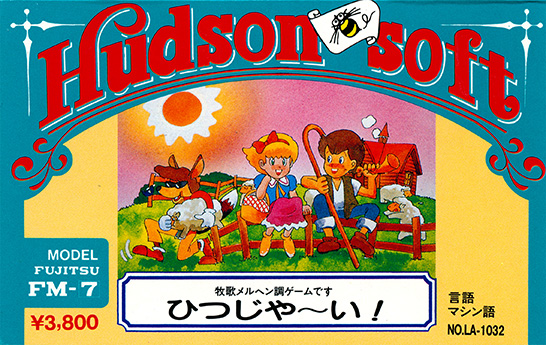
Released By – Hudson Soft
Catalog ID – LA-1032
Programmed by – Kikuta Masaaki
Download ROM (T77)
Download ROM (WAV)
Download 1200DPI RAW Scan Images (External Link)
In Hey Sheep! you control a shepherd boy who must gather his sheep into the fencing before nightfall so he can go on a date with a girl. You can catch the sheep by running into them and then once you drag them to the top of the screen you can close the gate by pressing up on the underside of it and going in the direction to shut it. In later levels a wolves appear which will open the gate when the pass by it allowing the sheep a chance to escape. If you fail to get all the sheep locked away safely by nightfall the game is over. The game is done by Kikuta Masaaki who did other romance themed games such as Nuts and Milk and Binary Land. He is known for hiding messages in his games, so I can’t help but wonder if he did in this one?
Movement is done by the numpad, 8 is up, 6 is right, 2 is down and 4 is left.
We previously dumped the MZ-2200 version of this game.
600DPI Scans –
Killer Station / キラーステーション (1983)
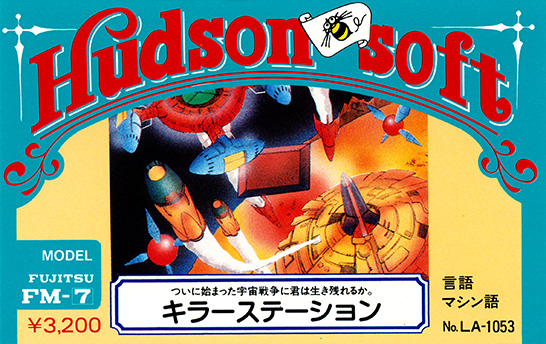
Released By – Hudson Soft
Catalog ID – LA-1053
Programmed by– Unknown
Download ROM (T77)
Download ROM (WAV)
Download 1200DPI RAW Scan Images (External Link)
Killer Station is a Space Invaders-like game in which you control a missile platform and try to shoot down the “Killer Stations” while avoiding being hit by their missiles. You’ll find you’re constantly being blocked by shooting the enemies either due to the “Barrier Satellites” – they’ll drop down on top of your ship to block your missiles – or more annoyingly the floating blue orbs which are “Space Mines”. These will go away temporarily once shot but if a “Mine Carrier” appears and crosses the screen they will all reappear! You’ll know a “Mine Carrier” is moving across the screen as you’ll hear an alarm sound. When you move your missile platform you’ll notice your missiles move too even after being shot so take note of that. Also even if the enemy missiles miss you they will star fires on the ground that you cannot pass until they burn out which can easily get you trapped. This game is rather hard and it is very annoying to hit the “Killer Stations” especially after a few levels.
The controls are done with the numpad, 4 moves you left and 6 moves you right while the Space key shoots the missiles.
600DPI Scans –
Yume no Puro Yakyū (Dream Professional Baseball) / 夢のプロ野球 (1983)
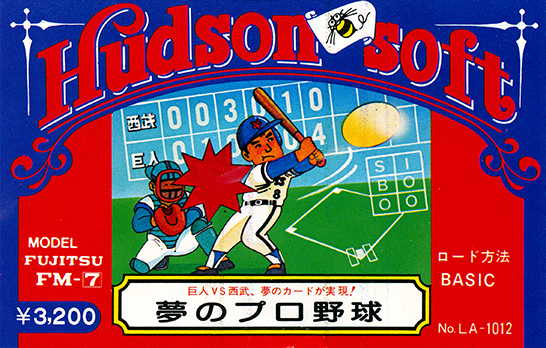
Released By – Hudson Soft
Catalog ID – LA-1012
Programmed by – Jun K.
Download ROM (T77)
Download ROM (WAV)
Download 1200DPI RAW Scan Images (External Link)
This game is basically a simulation of managing a baseball team. The only two teams involved however are the Saitama Seibu Lions and the Yomiuri Giants with what looks to be their rosters from 1982. You’re the coach of the team and make decisions regarding the batting and fielding lineups. Once the game begins you’ll watch as your line up goes against the other team and it will simulate the entire game to see who wins. During this you’re able to stop the play and swap pitchers or pinch hitters it seems. The game is entirely Japanese so I’m not 100 percent of what’s going on but that seems to be the basic gist of it.
600DPI Scans –
I wa Sanjutsu Nari (A Doctor Does Arithmetic) / 医は算術なり(1983)
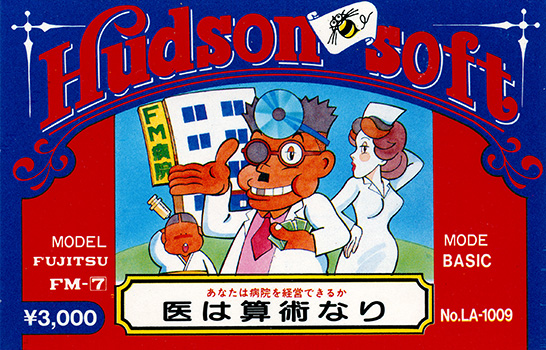
Released By – Hudson Soft
Catalog ID – LA-1009
Programmed by – M&M
Download ROM (T77)
Download ROM (WAV)
Download 1200DPI RAW Scan Images (External Link)
This game *might* be the first simulation game of running a hospital created beating out Theme Hospital by quite a while! The game title is a pun of sorts on the phrase “I wa Jinjustu Nari” which translates into something like “A Doctor is a Savior”. The game begins by telling you that after you made a lot of money you decided to become a medical doctor. You have 10,000,000 in yen you can take on in loans for ten years so your goal is to build a private hospital and make as much money as you can.
The game presents itself as a series of prompts, mostly the same year after year but the results of each year can end up being rather funny and crazy. The game is definitely lighthearted and you’ll see various oddball scenarios play out as you manage your hospital. I’ll discuss the ones I ran into in my play-through but there are likely many more! First you’re asked how big you want to build your hospital, how many nurses you’ll hire, how much you’ll advertise to find nurses, how much you’ll pay nurses and lastly how much medicine you’ll give your patients. Most of the prompts will be asking for numbers and the numbers you input are in the 10,000 yen increments so keep that in mind. At the end of each year it will tally up how many patients you had, how much your nurses cost as well as the interest on your loan. You can easily go negative on this game as I did but I think as long as you keep it above -300,000,000 yen the game will let you continue. The funny part kicks in during the end of most years when random scenarios occur. In my game I sold a mountain I inherited from my ancestors for a huge chunk of change, yakuza were admitted to the hospital and scared off my nurses, a competing hospital was built next to mine and stole all my nursing staff, I embezzled some money, and lastly I got in huge trouble and major fines for giving my patients too much medication and providing them with “vices”.
While difficult to play in Japanese if you get a basic gist of the prompts you’ll be able to play through it as they are generally the same each year. A bizarre and interesting simulation for sure!
600DPI Scans –
Attack on Pearl Harbor / 真珠湾攻撃 (1983)
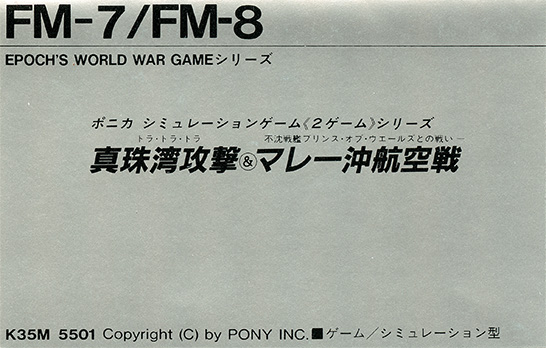
Released By – Pony Canyon
Catalog ID – K3M 5501
Programmed by – Takuya Kojima
Download ROM (T77)
Download ROM (WAV)
Download 1200DPI RAW Scan Images (External Link)
Attack on Pearl Harbor, part of the Epoch’s World War Game series, is an early war simulation game. You play as the Japanese in the historic attack on Pearl Harbor that happened in World War 2. The game is entirely in Japanese so it is difficult to understand if you’re an English-only speaker for sure. During gameplay you can basically dispatch attacks and choose the ships you’ll attack. You can also view the HP and defense of the various units. Upon attacking you’ll find out how many men you lost and how much damage you did to whatever unit you attacked. Lastly you can view a map and where the ships are positioned at the time. Hard to say much else as I lack the ability to play this game deeply without a knowledge of Japanese but that’s the basics of it.
600DPI Scans –
Sokoban / 倉庫番 (1982)
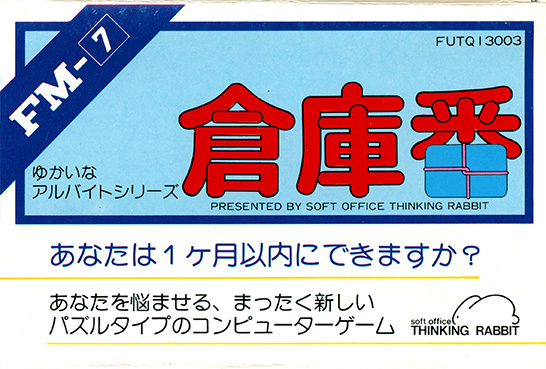
Released By – Thinking Rabbit
Catalog ID – FUTQ13003
Programmed by – Hiroyuki Imabayashi
Download ROM (T77)
Download ROM (WAV)
Download 1200DPI RAW Scan Images (External Link)
Sokoban! The classic Japanese puzzle game that has been ported many times to various systems and is sometimes better known as a Boxxle in the West due to that being its name on the Nintendo Game Boy. The gameplay is simple, you must control a character and push boxes onto the dots on each map to complete the level. If you make the slightest mistake though it usually means you have to begin the stage again. A devilishly challenging puzzle game that is sure to test your wits.
To control this game you’ll use the numpad, 1 is left, 2 is down 5 is up, and 3 is right. If you get stuck on a level you can press F1 and it will prompt you to reset the level. You’ll also need to do this once you get the blocks pushed on all the dots to complete the level. Annoyingly though if you walk over the dots they will disappear so you’ll need to remember where they are!
600DPI Scans –
Space Warp / スペースワープ (1984)
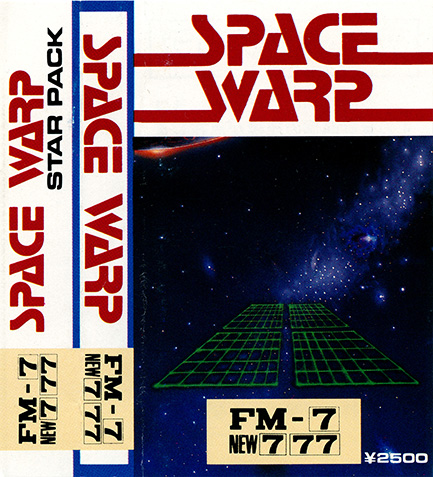
Released By – Star Pack
Catalog ID – N/A
Programmed by – Unknown
Download ROM (T77)
Download ROM (WAV)
Download 1200DPI RAW Scan Images (External Link)
Space Warp is a puzzle game in which you control a ship within four boxes that abstractly represent a three-dimensional cube. Your goal is to touch the letters in alphabetical order, but if you screw up, you lose! I could never figure out how to type the @ key to restart the level unfortunately so it is kind of a pain to play as it required me to reload the game completely each time I lost. Despite the simple look it can really mess with your head on how to navigate the boxes without colliding with the incorrect letters. There are 9 difficulty levels to pick from which seems to really just affect how much time you’re given to complete it.
To control you’ll use the numpad: 1 is right, 5 is up, 2 is down and 3 is right. You’ll also use 4 and 6 to switch boxes, but be careful you don’t move to a different box when there’s an incorrect letter there!
Ōzumō (Sumo Wrestling) / 大相撲
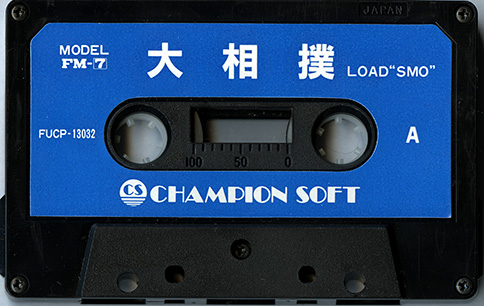
Released By – Champion Soft
Catalog ID – FUCP-13032
Programmed by – Masaaki Hatano
Download ROM (T77)
Download ROM (WAV)
Download 1200DPI RAW Scan Images (External Link)
In Ōzumō you will be entered into a sumo wrestling tournament to fight your way up the ranks. At the beginning of the game you’ll be asked to input your sumo wrestler’s name and select the difficulty level. Once you begin a match you’ll use various moves to try to take down your opponent. If you time your moves correctly you’ll win but do the wrong ones at the wrong time and your opponent can take you down! I honestly couldn’t really get the hang of the proper timing of moves as I can’t really tell what the computer is doing. Maybe sumo wrestling aficionado’s will be able to play this much better than I could.
I honestly don’t know a whole lot about sumo wrestling but I was able to get the moves you’re allowed to do somewhat translated. All are done with the numpad during matches.
1. Lift opponent from the ring
2. Throw
3. Use the edge of ring to toss advancing opponent past you
4. Grab the belt
6. Pull
7. Judo trip
8. Slap
9. Jump out of the way
600DPI Scans –
Ringu no Ue wa Ōsawagi (It’s a Bustle in the Ring!) / リングの上は大さわぎ (1984)

Released By – Micro Arts via Oh! FM
Catalog ID – FUJE-13001
Programmed by – Jun Amamai
Download ROM (T77)
Download ROM (WAV)
Download 1200DPI RAW Scan Images (External Link)
A professional wrestling game that looks pretty nice graphically but sadly I could never get the hang of it enough to win a match! I got some information on the background of this game from this website. Like many games of the time it was initially published in a magazine issue of Oh! FM (November 1984 to be exact). After that though it was improved upon with rope moves and other changes and was released separately on tape. It was heavily inspired by the Technos developed arcade game released by Data East called “The Big Pro Wrestling” (ザ・ビッグプロレスリング). This was also released in the US as “Tag Team Wrestling“.
You control your character with the numpad, as you can see in the second screenshot above. You also can use Break (Which is ESC on your keyboard) to select moves when grappling. However I could never really get this to work well and usually the CPU ended up doing a move to me instead. When you do time it correctly you’ll see moves flash up on the screen, which depending on the number of times you hit the ESC key will decide the move you do to the opponent. If you hit 0 after deciding on a move you’ll do it the the opponent. Each move costs you stamina as well so be careful. The 0 key will also tag you out to your teammate and pin your opponent. If you successfully pin the opponent you’ll win the match and move on to the next one (or so I assume – I’ve yet to successfully do it despite trying many times!
600DPI Scans –
Crash Ball / クラッシュボール (1984)

Released By – Champion Soft
Catalog ID – N/A
Programmed by – Pasoconics (パソコニクス)
Download ROM (T77)
Download ROM (WAV)
Download 1200DPI RAW Scan Images (External Link)
Crash Ball is a combination of golf and billiards. Your goal is to get your ball into the hole to advance to the next course. Like in golf you are given a par to try to shoot for on each course and if you finish under it you’ll get more points. You’ll get points for going slightly over it too it seems but not much. Hole in one’s are also worth a lot of points and that amount varies depending on the par. As you can see in the screenshot above you get 1500 points for a hole in one on the first course. The game is impressive and runs quite well on the FM-7! It even allows you to create and load your own courses if you wish.
To load the game you’ll need to answer N to every prompt you get. These are various questions asking you if you want to create or load a custom course and if you do that you’ll be unable to begin the game unless you have some created courses stored on a tape somewhere! If N isn’t working make sure you’re typing it with the shift key pressed. When the game begins you’ll see the course. To aim your ball you can hit the various numpad keys to see the direction it will be going. If you want to fine-tune your shot hit the arrow keys or plus and minus after this to incrementally move the angle of it. Once you are pointing in the direction you want to shoot then hit the space key. Your power meter will go up and down so then you’ll try to hit it at the appropriate power level. The ball will shoot forward and either bounce off walls, stop on its own, or go out of bounds. When you successfully hit the ball into the hole you’ll advance to the next course.
600DPI Scans –
Elevator Game / エレベーターゲーム

Released By – Star Pack
Catalog ID – N/A
Programmed by – Unknown
Download ROM (T77)
Download ROM (WAV)
Download 1200DPI RAW Scan Images (External Link)
Elevator Game is a pretty simple game in which your goal is to save the girl at the top of the building before she jumps to her death. You have 5 men to accomplish this and you’ll lose one each time you miss stepping into the next elevator. If you run out of lives you’ll naturally get a game over, but you can also get one if she jumps to her death and you don’t reach her on the top floor or catch her successfully from the ground level if she jumps.
To start the game you’ll need to press * near the numpad of your keyboard. To move your character you’ll press numpad 1 to go left and numpad 3 to go right. If you press numpad 5 your character will reach his arms up. This is for catching the girl if she jumps off the building. You have to time it correctly though or else she’ll still die.
600DPI Scans –
FM Racer / FMレーサー

Released By – Compac
Catalog ID – CC-1132
Programmed by – Hideki Takahata
Download ROM (T77)
Download ROM (WAV)
Download 1200DPI RAW Scan Images (External Link)
A simple racing game in which your goal is to make it 8700 meters before time runs out or you crash too many of your cars and it’s game over. If you reach 8700 meters the game will let you do another race. Quite difficult to survive that long though as the actual road is quite small and dodging cars successfully takes a lot of practice. The Best 5 list on the right is only populated if you make it to Race 2. A pretty generic racing game overall but somewhat impressive for the hardware.
To control the car you’ll press 1 to move it left and 3 to go right. 5 accelerates your car while 2 decelerates it. Naturally the faster you go the harder it is to control your vehicle but you’re racing against time as well so it’s a constant juggling act!
600DPI Scans –


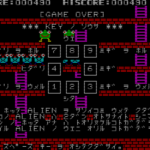
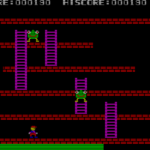
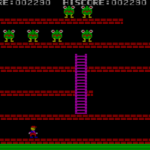
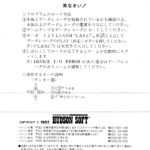
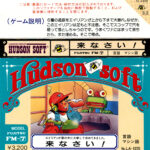
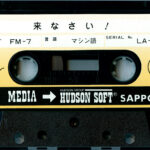
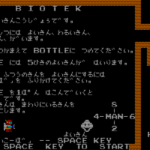
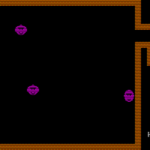
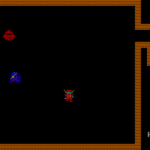
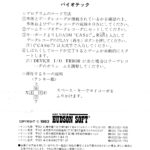
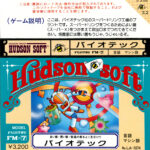
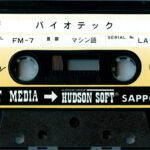
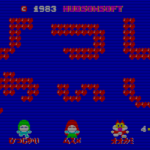
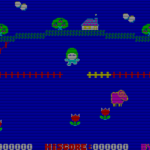
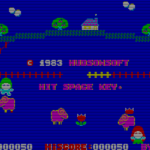
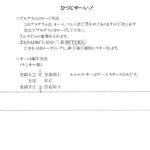
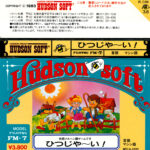
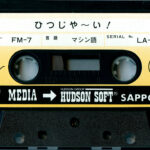
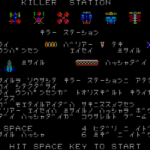
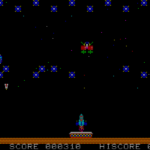
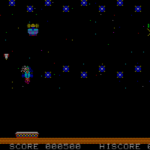
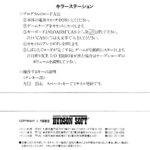
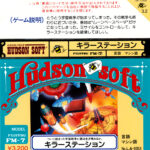
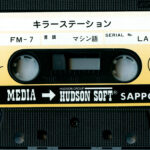
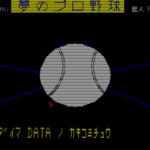
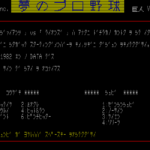
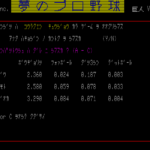
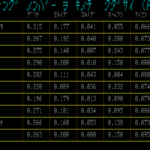
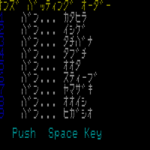
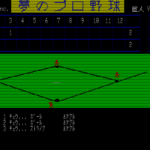
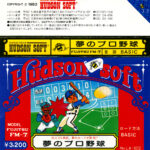
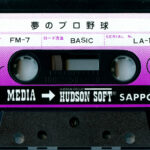
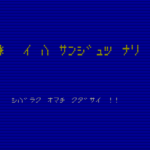
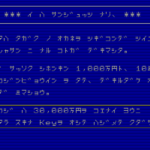
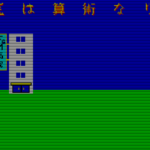
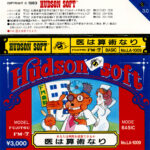
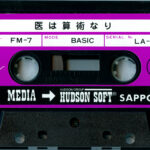
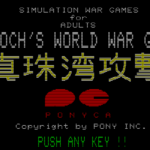
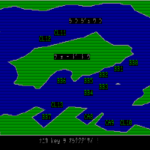
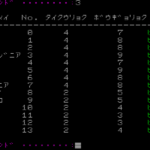
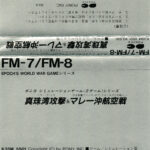
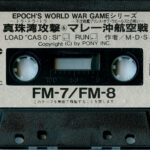
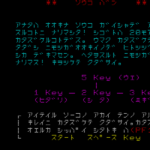
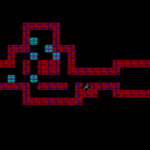
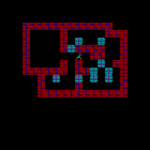
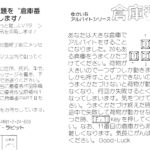
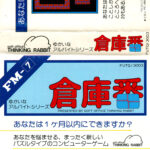
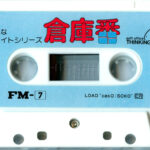
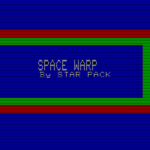
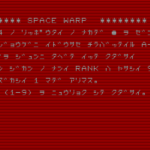
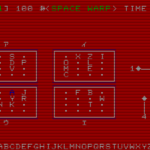
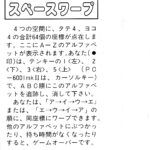
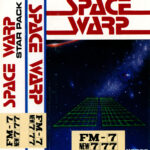
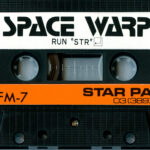
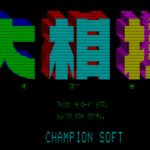
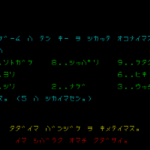
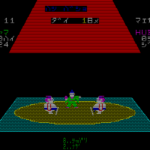
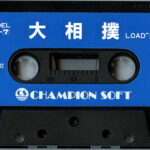



/cache_150x150/ringu no ue wa Ōsawagi (oh! fm) - tape.jpg)
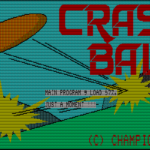
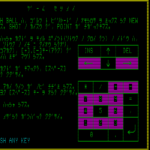
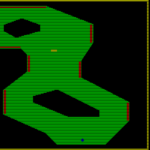
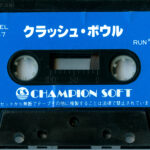



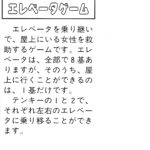
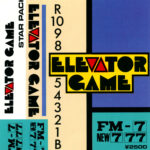
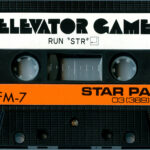



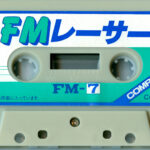





Your brief history of the FM-7 is somewhat inaccurate. The NEC competitor of the time was actually the PC-8001, which was also “discontinued” within a few years. The PC-8001 series was succeeded by the PC-8801 series, as the FM-7 (and FM-NEW7, which was basically the same computer) was succeeded by the compatible but extended FM77 series. Both series both went on to have long and successful runs, with improved models (especially incorporating graphics improvements) appearing every year or two well into the late ’80s.
The PC-88, FM77 and Sharp X series were the second “8-bit trinity” (8ビット御三家, which has a page available on Japanese Wikipedia) in Japan, succeeding the earlier NEC 8001, Sharp M and Hitachi Basic Master series.
I’m not clear on what the FM-7 designers were thinking when it came to games; the sound chip was a great addition, but why leave off joystick ports? (The optional FM—as in Yamaha FM synthesis—sound card option did include two joystick ports.) I’ve seen several units on Yahoo Auctions that look as if they had a joystick port bodged in, with a cable coming out next to the power inlet.
It’s great that there are people out there dumping Japanese PC software (esp. tapes) and actually making these historical artifacts available to the public, unlike some entities picking them up to hoard and not much else, ahem. It’s something I’ve considered doing myself, but import costs are unappealing. I will definitely throw some funds your way. I’d definitely pitch in for a bid if you happen to find undumped CDs for PC-8801MC games, especially the CD version of DIOS.
One suggestion for the article: I would translate 医は算術なり as “Medicine is arithmetic”. Doctor is 医者; 医 is the discipline. AはBなり is a fancy/old-fashioned way to say A is B.
Re: Curt’s comment, the cites Japanese Wikipedia page does place the FM-7 family as a direct competitor to the PC-8801 series. Early PC-8801 was about on par with the first generation FM-7 computer. The PC-8001 (even later revisions) has far inferior graphical capabilities.
Thank you for the information, kinds words and offer to help out with acquiring more stuff! If you ever want to throw some money our way you can at https://www.paypal.com/paypalme/dustinhubbard1